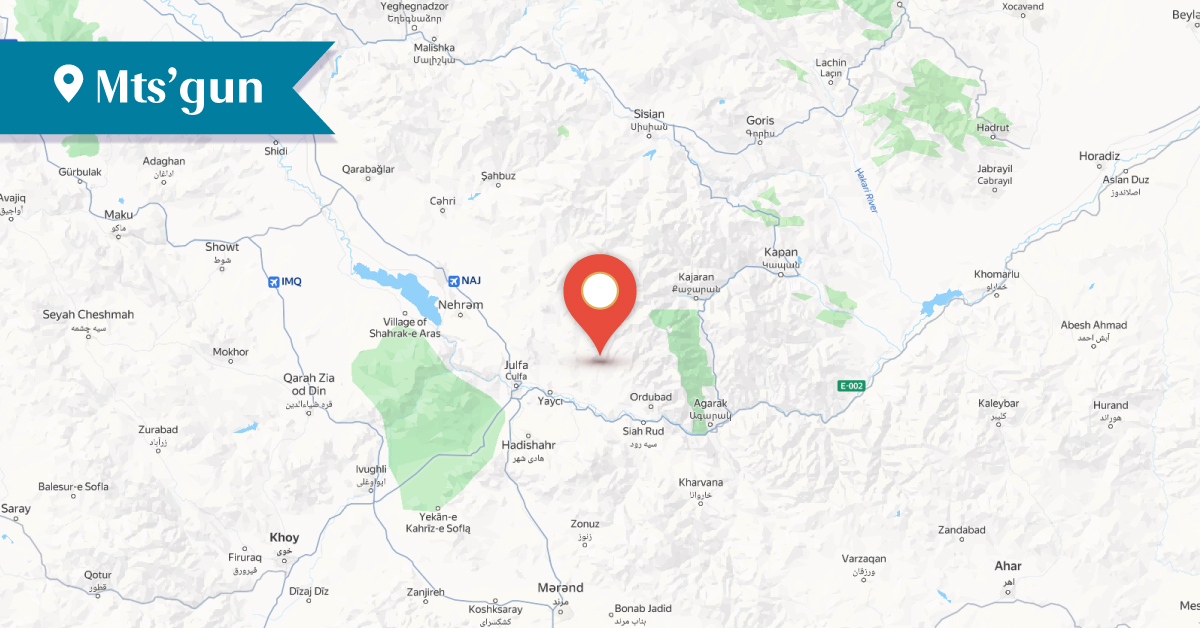2025
2025
2025-07-31

Mtsʻgun was one of the Armenian-inhabited villages of the Goghtn district in the Vaspurakan province of Greater Armenia. It was also known by the names Mzgun, Mizkunts Dasht, and Mskn.
Fragmentary information about this Armenian settlement has been preserved in historical sources. According to references, this village of Goghtn was located in the Tsghna gorge, about 3–4 km south of the village with the same name, in an elevated area.
A survey of the village site has revealed that it was a medium-sized settlement that could have accommodated about 160 households. The tombstones in the cemetery and other archaeological data indicate that Mtsgun was a developed settlement during the Middle Ages.
Until 2005, “Mizkunts Monastery,” [1] a pilgrimage site dedicated to Surb Stepanos (Saint Stephen), which was built in the 12th–13th centuries, was still standing. According to the 17th-century prominent figure of Armenian culture, Bishop Tovma Vanandetsi, pilgrims from Goghtn and the surrounding areas frequently visited this church. Based on the bishop’s preserved testimony[2]…
They came and reached
To the Goghtn district, beloved,
To the Church of St. Stephen,
Which is also called Mtsgun,
And with joy it was filled…”
The 17th-century Armenian pilgrim and traveler Zakaria Aguletsi wrote that on May 19, 1664, he visited the Monastery of Surb Stepanos in Mtsʻgun:
“On May 19, I, Zakaria, celebrated the Ascension of the Lord in Mtsgun, as we had come there with many pilgrims.” [3]
According to Ghevond Alishan, in the 18th century, during the 1730s, Catholicos Abraham of Crete also visited this monastery on his way to Old Jugha, referring to it by the name “Mizkunts Monastery.”[4]
Archbishop Mesrop Smbatyants called this monastery the “Monastery of Great Guno.”
The church was rebuilt several times. A study of the foundation revealed that the original structure had been built in the 11th–12th centuries. The last renovation of the church took place in 1895 through the donations of the people of Tsghna, as recorded in an inscription carved on the lintel of the church’s northern entrance. [5]
Surb Stepanos Monastery was renovated
thanks to the donations of the people of Tsghna,
under the patronage of Grigor Movsisyan
and Hayrapet Stepanents,
in the year 1895.
The church had two entrances, with northern and southern façades. Inscriptions carved in stone have been preserved on the northern, southern, and western façades of the church. Fragments of wall paintings dating back to the 19th century have survived. No sculptural depictions or ornamental carvings have been preserved.
On the northern and western façades of the church, nine elegantly carved khachkars (cross-stones) dating from the 11th to the 17th centuries were installed, seven of which had worn and eroded inscriptions.
A Gospel copied here and dated to the 1450s–1480s has also been preserved. [6]
Beginning in the mid-18th century, the village was gradually abandoned and by the 19th century had turned into ruins. Today, only insignificant traces remain of this ancient Armenian village, which is located in the Ordubad district of the Nakhijevan Autonomous Republic.
Bibliography
Ghevond Alishan, Sisakan, Venice, 1893.
The Journal of Zak’aria of Agulis, Yerevan, 1938.
Yervand Lalayan, Nakhijevan Province, Book XI, 1904.
A. Ayvazyan, The Historical and Architectural Monuments of Nakhijevan, Yerevan, 1978.
A. Ayvazyan, The Architectural Monuments of Tsʻghna, Etchmiadzin journal, 1978, No. 3.
A. Ayvazyan, The Armenian Monuments of the Nakhijevan ASSR: A Comprehensive List, Yerevan, 1986.
A. Ayvazyan, The Monumental Memorials and Relief Carvings of Nakhijevan, Yerevan, 1987.
Nakhijevan Atlas, Research on Armenian Architecture Foundation, Yerevan, 2012.
T. Kh. Hakobyan, St. T. Melik-Bakhshyan, H. Kh. Barseghyan, Dictionary of Toponyms of Armenia and Adjacent Regions, Vol. 3, Yerevan, 1991.
[1] Yervand Lalayan, Nakhijevan Province, Book XI, 1904, p 322.
[2] Ghevond Alishan, Sisakan, Venice, 1893, p. 343.
[3] The Journal of Zak’aria of Agulis, Yerevan, 1938, p 63.
[4] Ghevond Alishan, Sisakan, Venice, 1893, p. 343.
[5] A. Ayvazyan, The Monumental Memorials and Relief Carvings of Nakhijevan, Yerevan, 1987, p. 43.
[6] T. Kh. Hakobyan, St. T. Melik-Bakhshyan, H. Kh. Barseghyan, Dictionary of Toponyms of Armenia and Adjacent Regions, Vol. 3, Yerevan, 1991, p. 880: